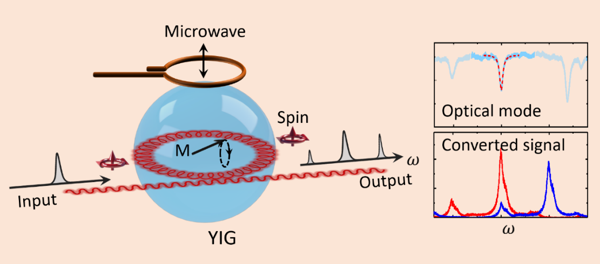Coherent conversion of microwave and optical photons can significantly expand the capabilities of information processing and communications systems. However, the quantum information technology based on the most promising superconducting qubits is operated at cryogenic temperature with microwave photons, which cannot achieve long-distance communications between qubits.
Unlike microwave photons, the optical photon can transmit via low loss optical fibers, making them suitable for long-distance communications. Thus, frequency conversion between a microwave photon and an optical photon has attracted great interest.
An important application based on magnons is the realization of frequency conversion between microwave photons to optical photons. Magnons can be coupled to microwave photons and in some materials (yttrium iron garnet) very easily achieve strong coupling or even ultra-strong coupling. And they can also interact with photons by the Faraday effect. Therefore, magnons can serve as a very promising platform for achieving microwave-to-optical frequency conversion, especially with excellent tunability and a long lifetime.
In recent years, researchers have realized the microwave-to-optical conversion in a yttrium iron garnet (YIG) microcavity. This conversion is mainly achieved through Brillouin scattering in the microcavity, two optical modes with different polarizations and a magnon mode to achieve a three-mode resonance effect (the frequency difference between the two optical modes is equal to the frequency of the magnon), thus generating a single sideband (SSB). The three modes in this system need to strictly satisfy the selection rule (angular momentum conservation), so this will limit the tunability of the system, sacrificing the advantage of the excellent tuning performance of the magnons.
The research group led by Prof. C. H. Dong from the University of Science and Technology of China, demonstrated a wide tuning range of single-sideband transducer. The research results are published in Photonics Research, Volume 10, Iss. 3, 2022 (Cheng-Zhe Chai, Zhen Shen, Yan-Lei Zhang, Hao-Qi Zhao, Guang-Can Guo, Chang-Ling Zou, Chun-Hua Dong. Single-sideband microwave-to-optical conversion in high-Q ferrimagnetic microspheres[J]. Photonics Research, 2022, 10(3): 03000820).
This work demonstrates a new transducer that takes advantage of the spin-orbit coupling of light in a microcavity, using the modulation of the optical modes of resonance by the magnon through the Faraday effect, leading to the Stokes and anti-Stokes scattering. There are only two modes involved in the magneto-optical interaction in this system, which will greatly relax the transformation conditions so that the advantage of magnon tunability can be exploited. The tuning range of 2.5 GHz has been demonstrated in this work, which far exceeds that of previous converters based on three-mode resonance, showing the great potential applications in frequency conversion.
In addition, this work also demonstrates a very interesting phenomenon that the magnon can simultaneously modulate the resonant frequency and coupling strength of the optical modes in the microcavity, corresponding to the out-of-phase dispersive and dissipative modulations, which lead to the SSB microwave-to-optical conversion (Fig. 1).
This work is the first to achieve a large range of tunable single-sideband frequency conversion in a ferromagnetic material microcavity. Future work will focus on improving the conversion efficiency of single photons, by replacing the current spherical cavity with a disk cavity to increase the photomagnetic coupling strength and by introducing a second microcavity to generate mode splitting matching the frequency of microwaves. This novel method for the implementation of SSB microwave-to-optical conversion devices may play a special role in a hybrid quantum network, enabling quantum communication across microwave and optical domains.

Fig.1 Single sideband microwave-to-optical frequency conversion in a YIG microsphere.


